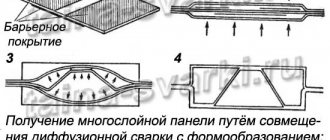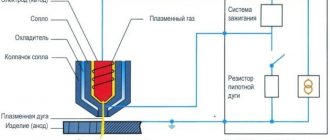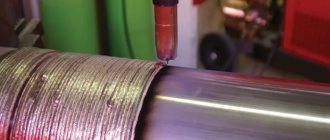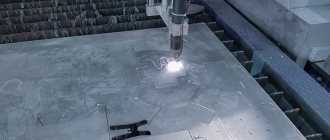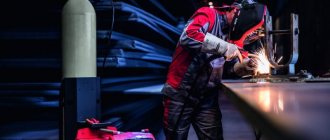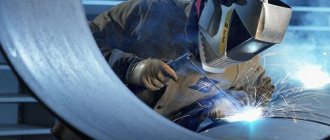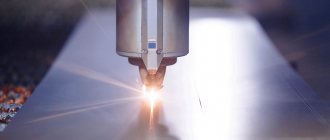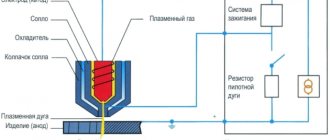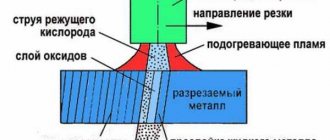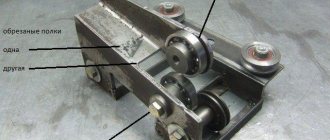One of the methods of processing metal used in construction, equipment production, fencing and for many other purposes is oxygen cutting. Its essence lies in the combustion of material under the influence of a gas stream. The process also involves the mandatory removal of toxins that inevitably form during work.
There are different technologies for oxygen cutting. For example, low-alloy and carbon steels can be cut only with pure oxygen, and for copper alloys, cast iron or high-alloy steels, the use of special fluxes is required. Cutting is carried out manually or using appropriate equipment.
The principle of oxygen metal cutting technology
The technology involves using the purest gas possible. The flow rate depends on its concentration. The better the gas mixture, the less it is required to complete the cut. Typically, oxygen is taken with a purity of 98–99%. When the indicator decreases by a percentage, not only does the consumption increase, but the speed of metal cutting also decreases.
Learn more about oxyfuel cutting technology
- Oxygen along with flammable gas comes out of the mouthpiece, combustion begins and a flame is formed, called a preheating flame.
- The metal is heated to combustion temperature. The supplied pure oxygen ignites the material. Combustion quickly spreads into the depth of the workpiece.
- A through hole is formed. The cutter moves, cutting through the metal.
The principle of oxygen cutting is based on the following processes: heating the metal, burning the material in oxygen and blowing out slag. Usually the heating flame is not extinguished. It stays lit throughout the entire operation. If it is extinguished, the metal will cool, oxygen will no longer support combustion, and cutting will stop.
Figure 1 — Metal cutting technology with oxygen
Technology Basics
Before starting cutting, it is recommended to heat the metal with a torch flame. This only applies to materials with a large cross-section. The mentioned flame appears due to the reaction of oxygen with gas. If you neglect this recommendation, the metal will inevitably begin to behave and warping will occur. However, if the geometric shape of the cut pieces is not important, for example, when carrying out work on dismantling structures made of construction steel, as well as when cutting thin-walled sheets, gas welding and oxygen cutting of metal without preheating the products is allowed.
High temperatures in the cutting zone are achieved by burning highly purified oxygen from a cylinder. Very high pressure metal tanks contain 99 to 99.8% oxygen. If oxygen of ordinary purity is used for heating (roughly speaking, atmospheric air), then for effective oxygen cutting of metal, it is precisely high-purity oxygen that is needed.
Oxygen cutting conditions
- the melting point is higher than the ignition temperature of the material in oxygen (the metal must burn in a solid state, then the cut will be even, its surface will be smooth, combustion products can be easily removed by a stream of oxygen);
- the melting temperature of slag is lower than the combustion temperature of the metal (liquid slag is easily removed from the cut);
- the heat generated must be sufficient to maintain combustion;
- the level of thermal conductivity of the metal should not be high (the incoming heat from the place where the material is cut is removed, which interferes with the cutting process);
- oxides arising during cutting should not be too viscous (for example, the presence of chromium and silicon in the metal composition leads to the formation of poorly blown slag and difficulty in the technological process).
Unalloyed and low-alloy steels meet the listed conditions for oxygen cutting. Aluminum, copper and gray cast iron do not meet these criteria.
Process mechanization
Over the past decades, robotics has developed very rapidly. Today, robots are used almost everywhere. And oxygen-arc cutting of metals is no exception. Nowadays, cutting equipment with numerical control will not surprise anyone. These machines can be equipped with several oxygen torches for cutting metal, which significantly increases their already high productivity. All leading foreign machine-building holdings and companies have long been actively introducing such equipment into their production chains, and domestic companies are also trying to keep up. The level of mechanization of welding work is on average about 80%.
Types of metals for oxygen cutting
Metals are suited to oxyfuel cutting to varying degrees. As already noted, low-carbon steels in which the carbon content does not exceed 0.3% are best cut in this way. If the level of this substance is more than 0.7%, then the process is difficult. High-carbon workpieces can only be sawed using oxygen-flux cutting. Fluxes are special powder additives supplied along with gas. Their task is to transform slag from refractory to fluid.
High alloy steels can also be cut with fluxes. Aluminum and aluminum alloys do not accept oxygen cutting. For them it is better to use the plasma-arc method.
Figure 2 - Oxygen cutting
Brass, copper, bronze are cut only with fluxes. A well-known component of the flux mixture is iron powder (IP) with particles of 0.07–0.16 mm. To cut stainless steel, aluminum powder (A1IB) is added to it. Ferrosilicon and aluminum-magnesium composition are also actively used.
Additional conditions for oxygen cutting when using fluxes:
- increasing the power of the heating flame by 20%;
- coordination of cutting speed with the amount of flux;
- increased distance between the mouthpiece and the metal.
Features of oxygen-flux cutting of cast iron
When burned, flux produces a lot of heat. So much so that the so-called cast iron whitening occurs. The essence of this phenomenon is that carbon passes from a free state to a bound state. In other words, carbon atoms in a certain area form a chemical compound with metal atoms. This is accompanied by a deterioration in the mechanical properties of cast iron (hardness increases, it becomes more brittle). As a result of accelerated heating and cooling, cracks appear on the surface, which can cause destruction of the product.
The problem can be solved by preheating the metal and regulating its cooling rate. Only a highly qualified worker with extensive experience in carrying out such work can cope with such tasks.
The influence of alloying elements on the cutability of steel during oxygen cutting
Typically, the presence of alloying elements makes oxyfuel cutting difficult. These components affect performance in different ways:
- silicon (Si), if its content is below 4%, complicates the process;
- manganese (Mn), if its content is above 4%, complicates the process;
- chromium (Cr), if its content is higher than 5%, complicates the process, causes self-hardening of the edges, and reduces the anti-corrosion resistance of the material;
- nickel (Ni), if its content is higher than 7%, complicates the process and causes the formation of cracks on the edges;
- titanium (Ti) has a good effect on cutability;
- tungsten (W), if its content is above 10%, complicates the process and increases the brittleness and hardness of steel.
Features of oxygen-flux cutting of non-ferrous metals and alloys
Like cast iron, copper must be heated before cutting. Heating is carried out to a temperature of 800–900 degrees Celsius. Copper has high thermal conductivity, so cutting without preheating will lead to significant warping, spatial distortion and defects.
Copper-based alloys with other elements (brass, bronze, etc.) also need to be heated. However, the preheat temperature should not exceed 500 degrees Celsius.
Cutting Features
Each metal workpiece requires its own approach. Let us dwell on the features of cutting sheets, forgings and pipes.
Sheet cutting
Manual technology is used to process sheets. In this case, acetylene, propane-butane and natural gas are often used as combustible gas. The first option is preferable, since when it is used, the heating time of the workpiece is minimal.
Sheets with a thickness of 3–300 mm are cut with cutters R2A-01 or RZP-01. For material up to 800 mm thick, specialized tools such as RZR-2 are required.
When cutting thin steel, overheating, warping of the metal and melting of the edges are possible. To prevent this, it is better to use cutting with a sequential arrangement of flame and oxygen. The flame power should be minimal and the operating speed should be maximum.
When using manual oxygen cutting, the following technological methods are relevant:
- burr-free cutting (allows you to obtain cuts without burrs (burrs, excess extruded metal) on the edges, implies the use of a nozzle with expansion at the outlet and oxygen with a purity of more than 99.5%));
- batch cutting (allows you to obtain high-quality cuts of thin sheets, involves pulling 1.5–2 mm thick blanks into one bundle).
Figure 3 - Sheet metal cutting
Cutting forgings and castings
As with sheet metal, it is important to choose the right cutter for manual oxyfuel cutting. The RZR-2 model, running on propane-butane with oxygen, is suitable for forgings and castings. The permissible thickness of cut products is 300–800 mm. In this case, it is important to monitor the speed and position of the torch. So, at the beginning of work it is placed at right angles to the surface. Towards the end of the cut, the speed should be reduced and the angle of inclination increased in the direction opposite to the movement.
Pipe cutting
Oxygen cutting of pipes is relevant for processing the ends of products for welding, removing defects and making holes. Flammable gas - acetylene or its substitutes. Pipes are cut manually in all spatial positions. For work, universal and insert cutters are used. The modes are set in accordance with the thickness of the metal.
Other nuances of gas cutting
The described technologies are used not only for sheets and pipes; oxygen cutting techniques are often used for profile rolling. The sequence of operations depends on the type of profile. The corners are cut from the edge, the I-beams are cut from the shelves to the rack.
Oxygen-arc and air-arc cutting
Oxygen-arc cutting is used for cutting carbon steels and is distinguished from arc cutting in that a stream of technically pure oxygen is applied to the metal heated to the point of melting, which intensively oxidizes the metal and removes the resulting oxides from the cut. When metal burns in a stream of oxygen, additional heat is generated, which speeds up the process of cutting metals. Steel tubes with an outer diameter of 8 mm and a length of 340-400 mm are used as electrodes. For stable arc burning, a special coating is applied to the electrode tubes. When the source voltage is turned on, the electrode is directed to the starting point of the cut at an angle of 80-85° to the surface being processed. During the cutting process, the cutter moves the cutter along the cutting line.
In practice, both separation and surface air-arc cutting . The essence of this cutting method is to melt the metal along the cut line with a carbon arc burning between the end of the carbon electrode and the metal, and to forcefully remove the molten liquid metal with a jet of compressed air. Air-arc cutting is used mainly when cutting carbon steels; non-ferrous metals and cast iron are less susceptible to air-arc cutting than steel. Air-arc cutting is used for trimming casting profits and removing defective areas of welds. The disadvantage of this cutting method is the carburization of the surface layer of the metal.
During manual separation cutting, the electrode is recessed into the metal being cut, the angle between the electrode and the surface of the metal being cut is 60-90°, and during surface cutting it does not exceed 30°. The electrode extension should not exceed 100 mm. During operation, the electrode burns and is periodically extended to the recommended value. It is not recommended to press the electrode, as when heated it becomes fragile and can break. The width of the groove is 1-3 mm larger than the diameter of the electrode used. Air-arc cutting modes are given in the table.
Air arc cutting modes
| Electrode diameter, mm | Current, A | Air pressure, MPa | Thickness of cut metal, mm | Cutting width, mm |
| 4 | 200-240 | 0,6 | 5 | 6 |
| 8 | 370-390 | 0,5 | 25 | 10 |
| 12 | 500-580 | 0,6 | 25 | 14 |
Welding generators or welding rectifiers are used as power sources. Compressors with a capacity of 20-30 m3/h are used to supply air.
The quality of cutting largely depends on the qualifications of the cutter. The cutter should move evenly during cutting; the electrode should not touch the metal, as this leads to local carburization.
Oxygen cutting equipment
Since acetylene is often used for work, equipment for acetylene welding is often used. Instead of welding torches, they use gas cutters. The most common option is an injection-type cutter.
In their design, cutters differ significantly from burners. They have additional tubes through which cutting oxygen is supplied, and tips with small holes for a mixture of gases. The central hole is provided for supplying cutting oxygen.
Figure 4 — Installation diagram for oxygen cutting
Working Principle of Oxygen Cutting Machine:
- the workpiece is positioned horizontally, the cutter valves are closed;
- the oxygen valve opens, and then the flammable gas valve;
- the mixture ignites and is regulated in power;
- the metal heats up over the cut area;
- a valve with cutting oxygen opens, activating combustion when it reaches the heated metal;
- oxides appear in the process, they are removed with a stream of oxygen;
- When finishing work, first close the cutting oxygen valve, then the flammable gas valve, and finally the burner.
The main tool of the oxyfuel cutting kit is the cutter. There are classifications of these elements:
- by type of flammable gas (cutters for liquid flammable mixtures, acetylene, substitute gases);
- degree of automation (manual, machine);
- purpose (special and universal);
- mixing of gases (non-injector and injection);
- flame power (high, medium, low).
Benefits of oxyfuel cutting
The technology of oxygen and oxygen-flux cutting has many advantages. Among them:
- large thicknesses of cut metal (up to 500 mm), limited only by the design features of oxygen-flux cutting installations;
- low cost;
- high quality (modern machines make it possible to achieve an acceptable cutting width, no cutting taper, clean edges that do not require processing);
- possibility of using multi-cutter schemes.
High-quality oxygen cutting is carried out by MetiStr specialists, who have high-precision machines and extensive experience in their arsenal.
All articles >
Surface preparation
If the task is to cut a large object into transportable pieces that is subject to disposal, then you don’t have to deal with surface preparation. The cutter will cope with this task in the shortest possible time. Another thing is the production of new products. In this case, it is important to obtain a high-quality cut line that is free of scale and other unwanted inclusions. Oxygen cutting of metal is preceded by thorough cleaning of the material.
There are a large number of methods for removing contaminants. The most popular of them are heating the surface with a gas flame and mechanical cleaning. The first method is the simplest. It allows you to effectively eliminate scale - the worst enemy of the gas welder. Its essence lies in heating the metal surface to critical temperatures. The second method is more expensive and requires special equipment (sandblasting machines, scrapers, brushes, etc.) and qualified workers.
